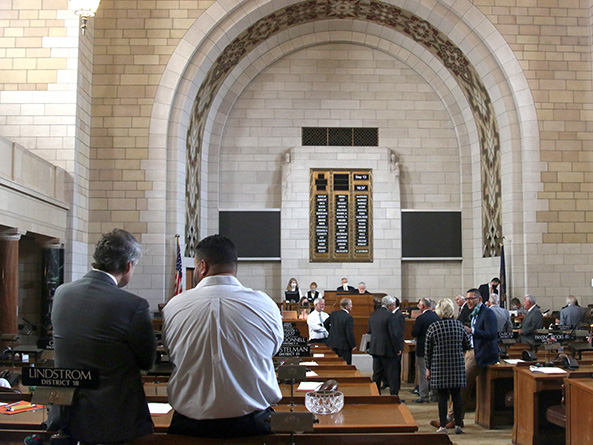Legislature convenes to redraw district boundaries
Lawmakers gathered at the State Capitol Sept. 13 to begin a three-week special session with the goal of adopting new political district boundaries to reflect population changes.
The state constitution requires the Legislature to redraw certain state political district boundaries every 10 years following the federal census. This is done to adjust district size to account for population shifts and to attempt to ensure equal representation for Nebraskans who live in those districts.
Senators will set new boundaries for Nebraska’s three U.S. House of Representatives districts, 49 legislative districts and those of the Nebraska Supreme Court, Public Service Commission, State Board of Education and University of Nebraska Board of Regents.
LR134, adopted by the Legislature earlier this year, sets criteria intended to ensure that the redistricting plans are constitutionally acceptable.
Under the guidelines, senators will use 2020 U.S. Census population data and census geography to establish district boundaries.
Boundaries must follow county lines “whenever practicable” and result in districts that are compact and contiguous. As far as possible, boundaries also must define districts that are easily identifiable and understandable to voters, preserve communities of interest and allow for the preservation of the core of prior districts.
Under the guidelines, lawmakers may not establish district boundaries with the intention of favoring a political party or any other group or person, and they cannot consider the political affiliations of registered voters, demographic information other than population figures or the results of previous elections.
The criteria also prohibit district boundaries that would result in the unlawful dilution of any minority population’s voting strength.
Under LR134, senators will draw congressional districts with populations as close to equal as practicable, with an overall range of deviation at or approaching zero percent. No plan may be considered that results in an overall range of deviation of more than 1 percent or a relative deviation of more than 0.5 percent from the ideal population.
For the remaining districts, the Legislature may not consider a plan that results in an overall range of deviation of more than 10 percent or a relative deviation of more than 5 percent from the ideal population.
On Sept. 13, the Redistricting Committee introduced its proposed redistricting plans as a package of eight bills.
LB1 contains a proposed Congressional redistricting plan created by Elkhorn Sen. Lou Ann Linehan, the committee’s chairperson. LB2 contains an alternative plan created by Sen. Justin Wayne of Omaha, the vice chairperson.
Linehan and Wayne also created competing legislative redistricting plans, contained in LB3 and LB4, respectively.
LB5, LB6, LB7 and LB8 contain proposed redistricting plans for the Public Service Commission, state Supreme Court, State Board of Education and Board of Regents, respectively.
Currently, all of Douglas County is within the 2nd Congressional District, along with roughly the western two-thirds of Sarpy County. Linehan’s proposed redistricting plan would move much of northern Douglas County into the 1st District. All of Saunders County, which currently is in the 1st District, and Sarpy County would be in the 2nd Congressional District.
Wayne’s proposal would leave all of Douglas County in the 2nd District. It would move portions of Sarpy County, including part of Bellevue, from the 1st District to the 2nd District. The rest of Sarpy County would become part of the 1st District.
Both proposals would make several changes to legislative districts across the state. They each would move one district from greater Nebraska to the Omaha metro area to account for a population shift from west to east.
Linehan’s proposal would merge parts of existing districts 23 and 24 and create a new district 24 in southeastern Saunders and western Sarpy counties. Wayne’s plan would move District 44 from southwestern Nebraska to southwestern Douglas and western Sarpy counties.
The committee will hold public hearings on the plans this week in each of Nebraska’s three Congressional districts. Hearings will be held:
- Sept. 14 at 1:30 p.m. at Central Community College, 3134 W Hwy 34, Room 555, Health Science Education Center, in Grand Island;
- Sept. 15 at 9 a.m. at the State Capitol, 1445 K St., Room 1524, in Lincoln; and
- Sept. 16 at 10 a.m. at the Scott Conference Center, 6450 Pine St., in Omaha.
The hearings also will be livestreamed on the Legislature’s website.
Following the hearings, the committee will review the proposed plans for advancement to the full Legislature for consideration. Floor debate is scheduled to begin Sept. 17, and lawmakers are expected to complete their work by Sept. 30.


